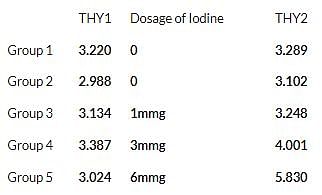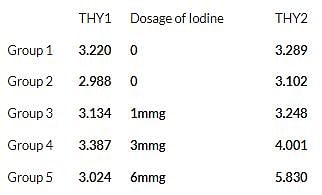Test: ACT Biology Research Summaries Questions - ACT MCQ
10 Questions MCQ Test Science for ACT - Test: ACT Biology Research Summaries Questions
Sleep plays a vital role in defining the daily activities of virtually all animals. During periods of sleep, the parasympathetic nervous system becomes active and induces a relaxed state in response to increased levels of the hormone melatonin. Yet, despite its ubiquity in the animal kingdom, the purpose of sleep and its role in our daily lives has been disputed by scientists. Two scientists discuss their theories about the purpose of sleep.
Scientist 1
During periods of sleep, animals are able to conserve energy that they would otherwise be spending on unnecessary activity. If an animal’s primary food source is most abundant during daylight, it is a waste of precious energy to be moving about at night. For example, many herbivores, such as squirrels, are diurnal (sleep during the night) because their food source is available during the day, while many insectivores, such as bats, are nocturnal (sleep during the day) because their food source is available during the night. Food sources, as an animal’s most valuable resource, dictate their sleep cycles. Many animal traits observable today evolved as a result of the supply and demand of food in their natural habitat.
Scientist 2
During waking hours, it is true that the body utilizes large amounts of energy. However, the role of sleep is to restore biological products that were utilized during periods of wakefulness, rather than simply avoid utilizing energy in the first place. Many types of biological molecules, such as hormones, are released throughout the body while an animal is active. Sleep serves as a period of inactivity during which the body can manufacture and store a supply of these molecules for future use during the next period of activity. Furthermore, sleep allows the body to repair cellular damages that has accumulated during waking hours. Experimental evidence shows that when animals are deprived of sleep, their immune system quickly weakens and death rates increase. Sleep is necessary for animals to prevent accumulation of damage and to regenerate crucial biomolecules for daily life.
Q. Which of the following, if true, would most support Scientist 2?
Sleep plays a vital role in defining the daily activities of virtually all animals. During periods of sleep, the parasympathetic nervous system becomes active and induces a relaxed state in response to increased levels of the hormone melatonin. Yet, despite its ubiquity in the animal kingdom, the purpose of sleep and its role in our daily lives has been disputed by scientists. Two scientists discuss their theories about the purpose of sleep.
Scientist 1
During periods of sleep, animals are able to conserve energy that they would otherwise be spending on unnecessary activity. If an animal’s primary food source is most abundant during daylight, it is a waste of precious energy to be moving about at night. For example, many herbivores, such as squirrels, are diurnal (sleep during the night) because their food source is available during the day, while many insectivores, such as bats, are nocturnal (sleep during the day) because their food source is available during the night. Food sources, as an animal’s most valuable resource, dictate their sleep cycles. Many animal traits observable today evolved as a result of the supply and demand of food in their natural habitat.
Scientist 2
During waking hours, it is true that the body utilizes large amounts of energy. However, the role of sleep is to restore biological products that were utilized during periods of wakefulness, rather than simply avoid utilizing energy in the first place. Many types of biological molecules, such as hormones, are released throughout the body while an animal is active. Sleep serves as a period of inactivity during which the body can manufacture and store a supply of these molecules for future use during the next period of activity. Furthermore, sleep allows the body to repair cellular damages that has accumulated during waking hours. Experimental evidence shows that when animals are deprived of sleep, their immune system quickly weakens and death rates increase. Sleep is necessary for animals to prevent accumulation of damage and to regenerate crucial biomolecules for daily life.
Q. Which of the following, if true, would most support Scientist 1?
| 1 Crore+ students have signed up on EduRev. Have you? Download the App |
Sleep plays a vital role in defining the daily activities of virtually all animals. During periods of sleep, the parasympathetic nervous system becomes active and induces a relaxed state in response to increased levels of the hormone melatonin. Yet, despite its ubiquity in the animal kingdom, the purpose of sleep and its role in our daily lives has been disputed by scientists. Two scientists discuss their theories about the purpose of sleep.
Scientist 1
During periods of sleep, animals are able to conserve energy that they would otherwise be spending on unnecessary activity. If an animal’s primary food source is most abundant during daylight, it is a waste of precious energy to be moving about at night. For example, many herbivores, such as squirrels, are diurnal (sleep during the night) because their food source is available during the day, while many insectivores, such as bats, are nocturnal (sleep during the day) because their food source is available during the night. Food sources, as an animal’s most valuable resource, dictate their sleep cycles. Many animal traits observable today evolved as a result of the supply and demand of food in their natural habitat.
Scientist 2
During waking hours, it is true that the body utilizes large amounts of energy. However, the role of sleep is to restore biological products that were utilized during periods of wakefulness, rather than simply avoid utilizing energy in the first place. Many types of biological molecules, such as hormones, are released throughout the body while an animal is active. Sleep serves as a period of inactivity during which the body can manufacture and store a supply of these molecules for future use during the next period of activity. Furthermore, sleep allows the body to repair cellular damages that has accumulated during waking hours. Experimental evidence shows that when animals are deprived of sleep, their immune system quickly weakens and death rates increase. Sleep is necessary for animals to prevent accumulation of damage and to regenerate crucial biomolecules for daily life.
Q. An animal is deprived of sleep for three days. According to Scientist 1?
A scientific experiment is conducted to test if calcium can affect gene regulation. Scientists hypothesized that high levels of calcium would interact with the proteins Cs3 and Gfy, which in turn would increase the transcription of genes F4597 and BC392. The experiment procedure is summarized below.
- Isolate the genes F4597 and BC392.
- Create a vector within yeast cells containing the two genes
- Culture yeast cells
- Grow yeast cells in different growth mediums- one medium lacking calcium (plate A) and one medium with supplemented calcium (plate B)
Q. What might it suggest if both plates were found to have no gene activity?
A scientific experiment is conducted to test if calcium can affect gene regulation. Scientists hypothesized that high levels of calcium would interact with the proteins Cs3 and Gfy, which in turn would increase the transcription of genes F4597 and BC392. The experiment procedure is summarized below.
- Isolate the genes F4597 and BC392.
- Create a vector within yeast cells containing the two genes
- Culture yeast cells
- Grow yeast cells in different growth mediums- one medium lacking calcium (plate A) and one medium with supplemented calcium (plate B)
Q. Would new information about the lack of absorption of calcium through a growth medium strengthen or weaken this experiment and why?
A scientific experiment is conducted to test if calcium can affect gene regulation. Scientists hypothesized that high levels of calcium would interact with the proteins Cs3 and Gfy, which in turn would increase the transcription of genes F4597 and BC392. The experiment procedure is summarized below.
- Isolate the genes F4597 and BC392.
- Create a vector within yeast cells containing the two genes
- Culture yeast cells
- Grow yeast cells in different growth mediums- one medium lacking calcium (plate A) and one medium with supplemented calcium (plate B)
Q. What result would disprove the hypothesis?
Scientists studied a species of termites and looked at their foraging habitats across the United States. The termite’s population in a given tree was measured by the level of decomposition within a tree due to the termites eating the bark. The experiment also kept track of the level of shade tolerance for each species of tree. For the species of trees in this experiment, shade tolerance fell into two main categorizes- shade tolerant (ST) and intermediate shade (IS). Lastly, they recorded the average amount of rainfall in that given month for the species location being observed. The chart below summarizes the data. Scientists hypothesized that the level of decomposition would be highest in tree species with a higher average rainfall. In addition, they hypothesized trees allowing more shade would allow for more termites, and in turn more decomposition.

Q. Based on this experiment, the optimal foraging habitats of termites can best be described as __________.
Scientists studied a species of termites and looked at their foraging habitats across the United States. The termite’s population in a given tree was measured by the level of decomposition within a tree due to the termites eating the bark. The experiment also kept track of the level of shade tolerance for each species of tree. For the species of trees in this experiment, shade tolerance fell into two main categorizes- shade tolerant (ST) and intermediate shade (IS). Lastly, they recorded the average amount of rainfall in that given month for the species location being observed. The chart below summarizes the data. Scientists hypothesized that the level of decomposition would be highest in tree species with a higher average rainfall. In addition, they hypothesized trees allowing more shade would allow for more termites, and in turn more decomposition.

Q. According to the data in the chart, did the experiment support or disprove their hypothesis?
An experiment was done to look at the effects of iodine supplements on the production of the thyroid hormone thyroxine. Individuals in the study were divided into categorizes based on the dosage of iodine supplemented. The chart below summarizes the data collected. THY1 is the average amount of thyroxine in the group prior to taking the supplement. THY2 is the average amount of thyroxine in the group after three months of taking supplements.

Q. Group 2 was given a placebo supplement, which shows:
An experiment was done to look at the effects of iodine supplements on the production of the thyroid hormone thyroxine. Individuals in the study were divided into categorizes based on the dosage of iodine supplemented. The chart below summarizes the data collected. THY1 is the average amount of thyroxine in the group prior to taking the supplement. THY2 is the average amount of thyroxine in the group after three months of taking supplements.

Q. The results of this experiment strengthen the theory that:
|
486 videos|517 docs|337 tests
|

















